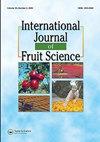Deriving Biomass Allocation and Carbon Stocks in Fruit Components of Strychnos Madagascariensis (Poir.) And Strychnos Spinosa (Lam.) In South Africa
IF 2.5
3区 农林科学
Q2 HORTICULTURE
引用次数: 0
Abstract
ABSTRACT Fruits contribute to carbon (C) fixation in fruit tree species of savannah woodlands despite that the C fixed in fruits is rapidly turned back to carbon dioxide (CO2) when the fruits decompose or are eaten. The aim of this study was to determine biomass allocation between fruit components of Strychnos madagascariensis and Strychnos spinosa and to derive the C stocks sequestrated by fruits. A total of 400 ripe fruits were harvested from trees distributed in seven plots across the UMkhanyakude district. Fruit shell and pulp were separated from seeds. Puree and juice of S. spinosa were separated by centrifugation and steam extraction, respectively. Moisture contents of the fruit components were measured. For S. madagascariensis fruits, seeds contributed the most biomass (50.2%), followed by the shell (30.8%), and pulp had the least biomass (16.7%). The loss of material was 2.3%. For S. spinosa, the largest part of fruit biomass was in the shell (41.8%), followed by puree (25.6%), seeds (18.6%), juice (6.2%), and pulp (0.9%). The loss of material was 6.9%. Fruit dry biomass (FDB; in g) and fruit carbon stocks (CB; in g) were both related to fruit diameter (D; in cm) for S. madagascariensis (FDB = 1.022 ᵡ D 2.492; CB = 0.463 ᵡ D 2.539) and S. spinosa (FDB = 1.015 ᵡ D 2.38; CB = 0.198 ᵡ D 2.821). Proportion values and regression techniques were both valid methods to derive biomass and carbon stocks of the fruit and its components.马钱子果实组分生物量分配和碳储量的研究和马钱子(林)。在南非
在热带草原林地的果树物种中,果实有助于碳(C)的固定,尽管果实中固定的碳在果实分解或被食用时迅速转化为二氧化碳(CO2)。本研究的目的是确定马钱子(Strychnos pinsposa)和马钱子(Strychnos pinsposa)果实组分之间的生物量分配,并得出果实固存的碳储量。共收获了400个成熟的水果,这些水果分布在UMkhanyakude地区的7块土地上。将果皮、果肉与种子分离。采用离心分离法和蒸汽萃取法分别分离棘叶果泥和汁。测定了果实各组分的水分含量。其中种子生物量最多(50.2%),其次是壳(30.8%),果肉生物量最少(16.7%)。材料损失率为2.3%。果壳生物量最多(41.8%),其次是果泥(25.6%)、种子(18.6%)、果汁(6.2%)和果肉(0.9%)。材料损失率为6.9%。果实干生物量(FDB);g)和水果碳储量(CB;g)均与果实直径有关(D;S. madagascar (cm), FDB = 1.022;CB = 0.463 r D 2.539)和棘松(FDB = 1.015 r D 2.38;Cb = 0.198 (d 2.821)。比例值和回归技术都是计算果实及其组分生物量和碳储量的有效方法。
本文章由计算机程序翻译,如有差异,请以英文原文为准。
求助全文
约1分钟内获得全文
求助全文
来源期刊

International Journal of Fruit Science
Agricultural and Biological Sciences-Agronomy and Crop Science
CiteScore
6.40
自引率
0.00%
发文量
64
审稿时长
10 weeks
期刊介绍:
The International Journal of Fruit Science disseminates results of current research that are immediately applicable to the grower, extension agent, and educator in a useful, legitimate, and scientific format. The focus of the journal is on new technologies and innovative approaches to the management and marketing of all types of fruits. It provides practical and fundamental information necessary for the superior growth and quality of fruit crops.
This journal examines fruit growing from a wide range of aspects, including:
-genetics and breeding
-pruning and training
-entomology, plant pathology, and weed science
-physiology and cultural practices
-marketing and economics
-fruit production, harvesting, and postharvest
 求助内容:
求助内容: 应助结果提醒方式:
应助结果提醒方式:


